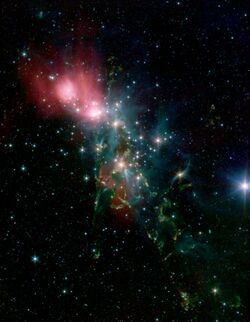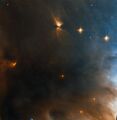Astronomy:NGC 1333
| Reflection nebula | |
|---|---|
 | |
| Observation data: J2000.0 epoch | |
| Right ascension | 03h 29m 11.3s[1] |
| Declination | +31° 18′ 36″[1] |
| Distance | 967 ly (296.5 pc)[1] ly |
| Apparent magnitude (V) | 5.6 |
| Apparent dimensions (V) | 6′ x 3′ |
| Constellation | Perseus |
| Designations | Ced 16, GN 03.26.1, LBN 741[2] |
NGC 1333 is a reflection nebula located in the northern constellation Perseus, positioned next to the southern constellation border with Taurus and Aries.[3] It was first discovered by German astronomer Eduard Schönfeld in 1855.[4] The nebula is visible as a hazy patch in a small telescope, while a larger aperture will show a pair of dark nebulae designated Barnard 1 and Barnard 2.[5] It is associated with a dark cloud L1450 (Barnard 205). Estimates of the distance to this nebula range from 980–1,140 ly (300–350 pc).[4]
This nebula is in the western part[4] of the Perseus molecular cloud and is a young region of very active star formation,[6] being one of the best-studied objects of its type.[4] It contains a fairly typical hierarchy of star clusters that are still embedded in the molecular cloud in which they formed,[7] which are split into two main sub-groups to the north and south. Most of the infrared emission is happening in the southern part of the nebula. A significant portion of the stars seen in the infrared are in the pre-main sequence stage of their evolution.[6]
The nebula region has a combined mass of approximately 450 M☉,[4] while the cluster contains around 150 stars with a median age of a million years and a combined mass of 100 M☉. The average star formation rate is 1×10−4 M☉ yr–1.[4] Within the nebula are 20 young stellar objects producing outflows, including Herbig–Haro objects, and a total of 95 X-ray sources that are associated with known members of embedded star clusters.[6] In 2011 researchers reported finding 30 to 40 brown dwarf objects in the cloud and in the Rho Ophiuchi cloud complex.[8]
15 objects with a spectral type of M9 or later were discovered in NGC 1333. This spectral type corresponds to a mass of a planetar-mass object (PMO) at the age of NGC 1333. About 42% of the PMO are surrounded by a circumstellar disk, but only one out of six objects with a spectral type of L0 (about 10 |♃|J}}}}}}) or later has a disk. Scholz et al. argues that this indicates that very low mass PMOs form like planets (aka ejected planets) and not like stars (also called sub-brown dwarfs).[9] Parker & Alves de Oliveira on the other hand argue that the distribution of PMOs in NGC 1333 follows N-body simulations of objects that form like stars and that none of the PMOs has a peculiar motion, which is predicted for ejected planets. They also note that ejected planets are hiding in this and star-forming regions.[10]
Gallery
A small region of NGC 1333 taken by Hubble Space Telescope.[11]
There are 5 Herbig–Haro objects (numbered 7 to 11) in NGC 1333.[12]
NGC 1333 by the Mount Lemmon Sky Center
The region south of NGC 1333 in infrared. It shows the dark clouds Barnard 203 and 204
References
- ↑ 1.0 1.1 1.2 Soubiran, C. et al. (November 2018). "Open cluster kinematics with Gaia DR2". Astronomy & Astrophysics 619: 11. doi:10.1051/0004-6361/201834020. A155. Bibcode: 2018A&A...619A.155S.
- ↑ "NGC 1333". SIMBAD. Centre de données astronomiques de Strasbourg. http://simbad.u-strasbg.fr/simbad/sim-basic?Ident=NGC+1333.
- ↑ Sinnott, Roger W.; Perryman, Michael A. C. (1997). Millennium Star Atlas. 1. Sky Publishing Corporation and the European Space Agency. ISBN 0-933346-84-0.
- ↑ 4.0 4.1 4.2 4.3 4.4 4.5 Walawender, J. et al. (December 2008). Reipurth, Bo. ed. NGC 1333: A Nearby Burst of Star Formation. ASP Monograph Publications. 1. p. 346. Bibcode: 2008hsf1.book..346W. http://www.ifa.hawaii.edu/publications/preprints/08preprints/Walawender_08-206.pdf. Retrieved 2020-08-15.
- ↑ Inglis, Michael (2004). Astronomy of the Milky Way. Springer London. p. 167. ISBN 1-85233-709-5. https://books.google.com/books?id=y4t_-459RPUC&pg=PA167.
- ↑ 6.0 6.1 6.2 Getman, Konstantin V. et al. (August 2002). "Chandra Study of Young Stellar Objects in the NGC 1333 Star-forming Cloud". The Astrophysical Journal 575 (1): 354–377. doi:10.1086/341219. Bibcode: 2002ApJ...575..354G.
- ↑ Schulz, Norbert S. (2005). From Dust To Stars. Praxis Publishing Limited. p. 213. ISBN 9783540237112. https://books.google.com/books?id=4xYTejZIKCQC&pg=PA213.
- ↑ "Rogue Failed Star Is One of Smallest Ever Seen". space.com. 11 October 2011. http://www.space.com/13253-tiny-rogue-failed-star-brown-dwarf.html.
- ↑ Scholz, Aleks; Muzic, Koraljka; Jayawardhana, Ray; Almendros-Abad, Victor; Wilson, Isaac (2023-05-01). "Disks around Young Planetary-mass Objects: Ultradeep Spitzer Imaging of NGC 1333". The Astronomical Journal 165 (5): 196. doi:10.3847/1538-3881/acc65d. ISSN 0004-6256. Bibcode: 2023AJ....165..196S.
- ↑ Parker, Richard J.; Alves de Oliveira, Catarina (2023-10-01). "On the origin of planetary-mass objects in NGC 1333". Monthly Notices of the Royal Astronomical Society 525 (2): 1677–1686. doi:10.1093/mnras/stad2378. ISSN 0035-8711. Bibcode: 2023MNRAS.525.1677P. https://ui.adsabs.harvard.edu/abs/2023MNRAS.525.1677P.
- ↑ "Champions League" (in en). https://www.spacetelescope.org/images/potw1944a/.
- ↑ "The smoking gun of a newborn star" (in en). https://www.spacetelescope.org/images/potw1853a/.
External links
- Agrupació Astronòmica d'Eivissa (AAE)
- Cala d'Hort Telescope (TCH)
- Spitzer Space Telescope page on NGC 1333
- NASA Astronomy Picture of the Day: Dusty NGC 1333 (24 November 2005)
- NASA Astronomy Picture of the Day: In the Center of Reflection Nebula NGC 1333 (21 May 2007)
- Amateur photography
- See NGC1333 in WorldWide Telescope
 |






